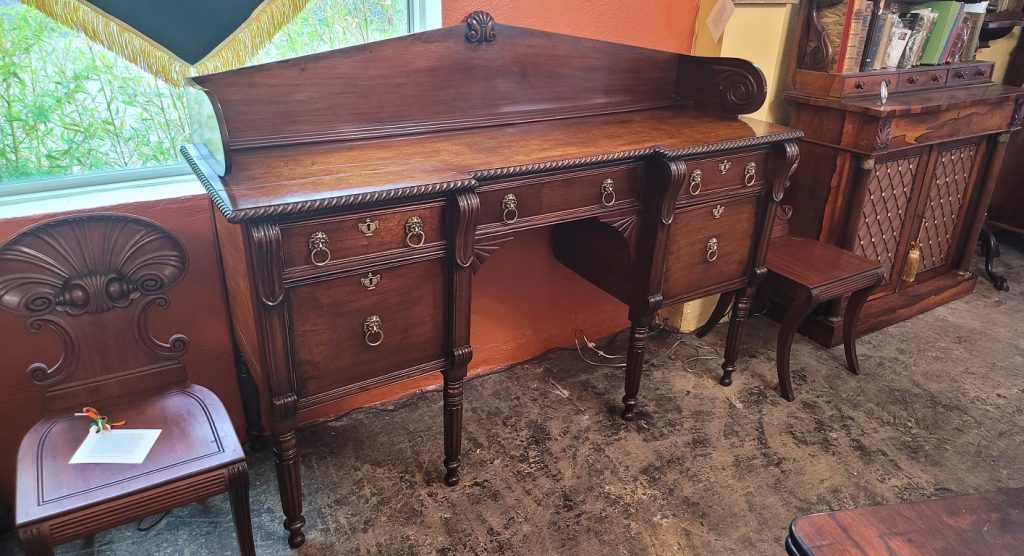18C Irish Georgian Cork Sideboard
PRESENTING A GORGEOUS and VERY RARE 18C Irish Georgian Cork Sideboard of lovely neat proportions.
Made in Ireland during the George III Era, circa 1790 and most likely made in the Southern City of Cork.
A STUNNING Irish provincial piece from the Georgian Era!
Made of solid mahogany, probably imported from Cuba and the secondary woods are oak (as one would expect). Beautiful dovetailing on the inside of the drawers.
The ‘hints’ that this is in fact an ‘Irish’ piece are numerous. The ‘scallop shell’ on the center of the back gallery is unmistakably an Irish Georgian signature. The scalloped fans beneath either side of the central drawer are likewise an Irish signal. The shape, design and style is entirely consistent with similar pieces made in Cork at the end of the 18th Century.
It has it’s original brasses which is fantastic. Lions Head Ring drawer pulls and stunning urn keyhole covers/escutheons.
It has a solid gallery back splat (with central Scallop) and on both sides this ends in curved and carved scroll ends. Beneath the back splat their is a grooved plank section for holding plates etc upright.
The server/counter top area is edged and banded with a carved rope style edging.
The mid section consists of 3 drawers and 2 doors.
The piece sits on 6 legs … 4 to the front and 2 to the rear. The front legs are pillars starting at the top with an acanthus style scroll … extending down to another scroll carving directly above the reeded and fluted legs. The 2 rear legs do not have the same fluting detail.
The 2 side doors open to reveal a simple one shelf storage area. One probably held a lead lined cellarette at one time.
The piece is in excellent condition for it’s age and use. There are some minor aging cracks on the counter top on the left hand side. A small loss of molding to the right lower door. No original keys but we are getting replacements made.
Bought in Surrey, England in 1999 by a Private Texas Collector and shipped to Texas. We have the original ‘sales invoice’ and the dealer sold it as a “Regency Mahogany Sideboard circa 1820’and told her that it was an English piece, for the sum of 3,400 GBP. Not only did the dealer not recognize the obvious ‘Irish’ signs, but also the fact that it was Georgian and not Regency. The sum paid for it then was considerably less than it’s real worth, as these pieces are ‘HIGHLY DESIRABLE and COLLECTIBLE’ due to their rarity. Allowing for simple inflation on the price paid in 1999, this would convert to approx. $9,500 in today’s value. The shipping from the UK to Texas would have cost circa $3,000.
IF YOU ARE A PROUD IRISH-AMERICAN WITH ROOTS IN COUNTY CORK,
THEN THIS IS A ‘MUST HAVE’!
The Georgian era is a period in British history from 1714 to c. 1830–37, named after the Hanoverian kings George I, George II, George III and George IV. The sub-period that is the Regency era is defined by the regency of George IV as Prince of Wales during the illness of his father George III. The definition of the Georgian era is often extended to include the relatively short reign of William IV, which ended with his death in 1837.
The term “Georgian” is typically used in the contexts of social and political history and architecture. The term “Augustan literature” is often used for Augustan drama, Augustan poetry and Augustan prose in the period 1700–1740s. The term “Augustan” refers to the acknowledgement of the influence of Latin literature from the ancient Roman Republic.
Link: https://en.wikipedia.org/wiki/Georgian_era
Cork (Irish: Corcaigh [ˈkɔɾˠkɪɟ], from corcach, meaning ‘marsh’) is the second largest city in Ireland and third largest city by population on the island of Ireland. It is located in the Southern Region and in the province of Munster. In the 2022 census, the first following an extension to the city’s boundary in 2019, the city had a population of 222,333.
The city centre is an island positioned between two channels of the River Lee which meet downstream at the eastern end of the city centre, where the quays and docks along the river lead outwards towards Lough Mahon and Cork Harbour, one of the largest natural harbours in the world.
Originally a monastic settlement, Cork was expanded by Viking invaders around 915. Its charter was granted by Prince John in 1185. Cork city was once fully walled, and the remnants of the old medieval town centre can be found around South and North Main streets. The city’s cognomen of “the rebel city” originates in its support for the Yorkist cause in the Wars of the Roses. Corkonians sometimes refer to the city as “the real capital”, a reference to its opposition to the Anglo-Irish Treaty in the Irish Civil War.
Link: https://en.wikipedia.org/wiki/Cork_(city)
18C Irish Georgian Cork Sideboard.
Provenance: Bought in Surrey, England in 1999 by a Private Texas Collector and shipped to Texas.
Condition: Very good condition (see full posting).
Dimensions: 47.75 inches Tall at highest point of back gallery (36 inches tall to the counter top) ,64.5 inches Wide, 22 inches Deep
SALE PRICE NOW: $14,800









































